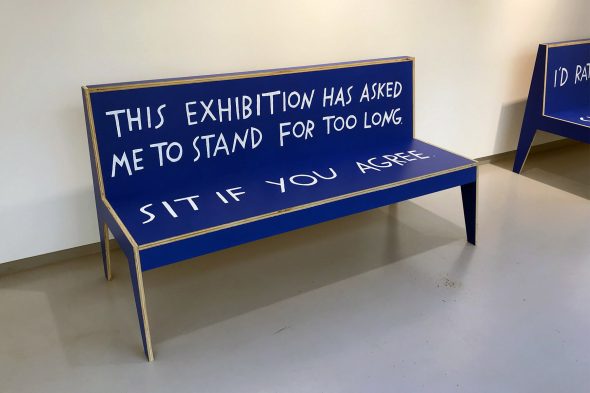Gallery 400 exhibit ‘Crip*’ tackles assumptions of what is ‘normal’

Artists featured in the current exhibition at Gallery 400 on the University of Illinois Chicago campus ask viewers of their work to question what it means to move through a world that both rejects and capitalizes on experiences that are not perceived as “normal.”
Through the pieces featured in “Crip*,” the artists, some of whom identify as disabled, address disability and intersectional thinking and their relationship to at least one non-normative identity.
The name of the exhibit, “Crip*,” references “Crip Theory” developed by writer Robert McRuer in his 2006 book, “Crip Theory: Cultural Signs of Queerness and Disability.” He describes how “compulsory heterosexuality,” the assumption that everyone is heterosexual, and “compulsory able-bodiedness,” which defines disability in terms of a lack or imperfection, rely on “non-normal” bodies and identities to exist. Normativity is essentially held in place, and defined by, all of the things that “it is not.”
“This exhibition not only challenges identity categories, it foregrounds the generative capacities within art and exhibition, making for imaginative and committed access. A number of works have image descriptions and captioning built into them. And curator Liza Sylvestre and Gallery 400 have ensured that audio and verbal descriptions are available in multiple formats,” said Lorelei Stewart, director of Gallery 400.
The exhibition, which opened Jan. 14 and continues through March 12, will culminate with a March 4-5 colloquium organized in collaboration with the UIC Disability Cultural Center, the art education programs on the University of Illinois Urbana-Champaign and UIC campuses, and Bodies of Work, a network of artists and organizations whose art showcases and celebrates the disability experience. The Krannert Art Museum on the UIUC campus also is involved with the project.
An important context for the pieces featured in the exhibit is that often artists are expected to “perform” their identities for the art world through the image of themselves. The result is that while this imaging diversifies the art world, it pigeonholes artists with non-normative identities and cements differences.
The 12 artists featured in “Crip*” are attuned to the concepts that exist beyond the reach of simplified identity distinctions or interpretations. For example, Emilie Gossiaux’s work is informed by her hearing and vision loss, but what drives her work is a broad interest and deep understanding of communication, interdependence, and the connection between sense and memory. Her sensory ability provides her with a unique vantage point but is not limiting. “Gossiaux is not interested in producing work that can be reduced to simply imagining her specific sensory composition,” Sylvestre said.

Alison O’Daniel’s expansive project “The Tuba Thieves” utilizes her understanding of sound both through her access to it and through her awareness of its absence due to her hearing loss. Her piece, “Scene 55 The Plants Are Protected,” beautifully relies on the generative space of translation. In fact, O’Daniel created her cinematic visuals based on sound scores produced by five different composers. Christine Sun Kim, a sound artist who is deaf, produced the sound score for “Scene 55.” “Through O’Daniel’s projects, we are able to reconsider the rich and liminal space formed between absence and presence,” according to the curator.
Alongside the exhibition, a “Crip*” Colloquium will be held March 4-5. The “Crip*” Colloquium, co-presented by Gallery 400 and the UIC Disability Cultural Center, is a gathering of artists, scholars and students to explore questions raised by the works on view in “Crip*.” Over two days, these talks, workshops, conversations, and experiments will critically engage the generative complexities of disability experience, media, accessibility practices and relationships to the normative. Details are forthcoming on the Gallery 400 and UIC Disability Cultural Center websites.
The exhibition is curated by Sylvestre, curator of academic programs at the Krannert Art Museum. The featured artists include Liz Barr, Shannon Finnegan, Emilie Gossiaux, Max Guy, Christopher Robert Jones, Carly Mandel, Darrin Martin, Alison O’Daniel, Berenice Olmedo, Carmen Papalia and Heather Kai Smith and Brontez Purnell.
A number of artists featured in the exhibition will participate in five conversations, artist talks and sound art events programmed alongside the exhibition. “Crip*” events featuring Max Guy, Berenice Olmedo, Christopher Robert Jones, Carmen Papalia and Sylvestre are detailed on the Gallery 400 website.
Also featured in conjunction with “Crip*” is the streetside exhibition, “Through My Lens: Justin Cooper, ” a collaboration with Bodies of Work. The photographs displayed on Gallery 400’s windows chronicle the artist’s wanderings and engagements with accessible and inaccessible areas in Chicago’s neighborhoods and beaches. Cooper, who uses a wheelchair, employs photography as a tool to address issues of access.
Cripping the Arts is a University of Illinois 2021–23 collaboration across the UIC and UIUC campuses intended to transform arts exhibition sites, art education and studio art practice through new ideas about disability. Cripping the Arts also includes new community partnerships, teacher training, and artist residencies.
Lead support for “Crip*” is provided by the University of Illinois Presidential Initiative: Expanding the Impact of the Arts and Humanities. Additional support is provided by the Andy Warhol Foundation for the Visual Arts and by the School of Art & Art History in the UIC College of Architecture, Design, and the Arts. This program is partially supported by a grant from the Illinois Arts Council Agency.
“Crip*” is co-presented by the Krannert Art Museum at UIUC, where additional support was provided by the James and Beth Armsey Fund and UIUC Disability Resources and Educational Services.
